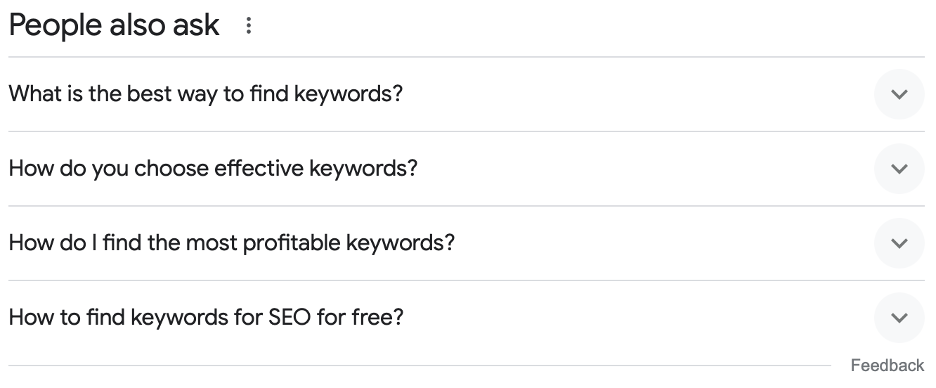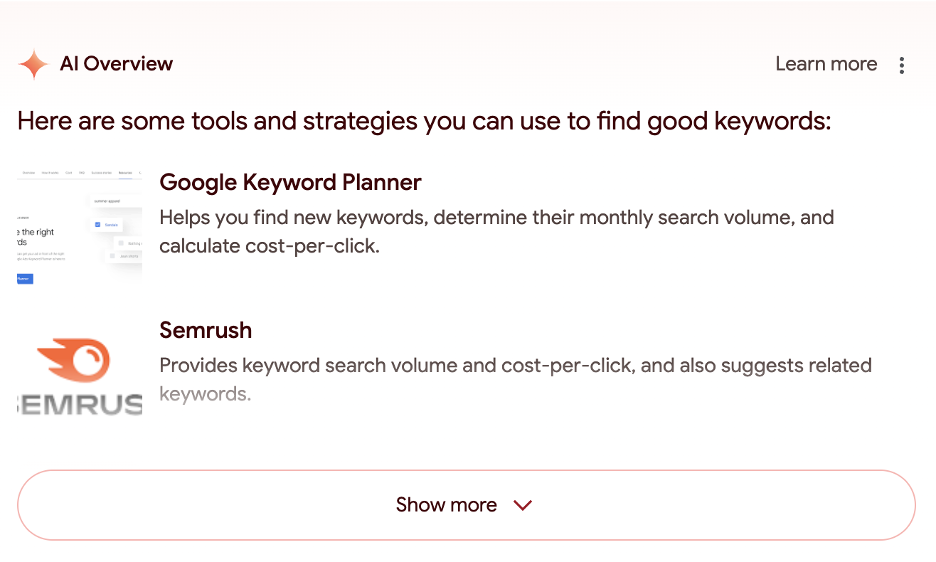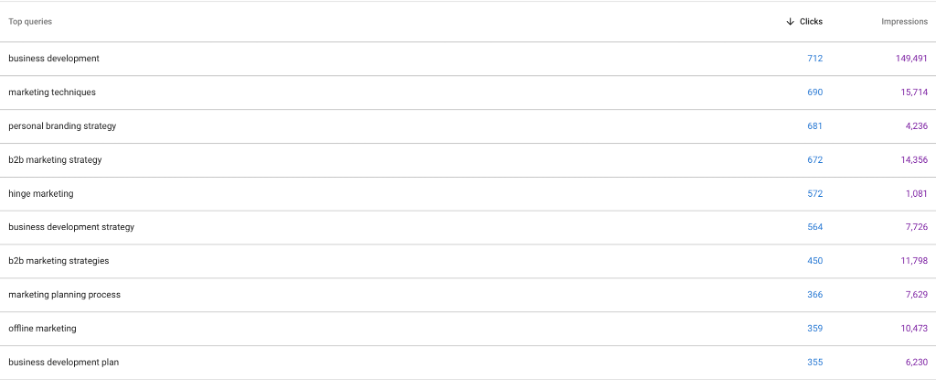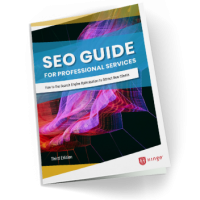Attracting organic search traffic to your website is arguably more difficult today than ever before. Not only is there increasing competition for top positions on search engine results pages (SERPs), Google’s recent updates have decreased the likelihood that search engine users will click-through to your website page.
Sponsored ads, answer boxes, and now AI overviews crowd the top portions of SERPs, presenting a new challenge for professional services marketers who are responsible for managing the performance of their firm’s website.
But abandoning your search engine optimization (SEO) efforts is not an option. Our High Growth Study has identified that the fastest growing businesses are more likely to dedicate effort to SEO than their slower growing peers. Therefore it is necessary to monitor and improve your website’s SEO—especially through the fundamental SEO technique of conducting keyword research.
At Hinge, we conduct keyword research as an integrated part of the digital marketing services we provide for our clients. Whether it’s writing a new blog post or implementing a complete website redesign, our team understands the importance of a keyword-driven approach. Utilizing proper SEO techniques allows us to track and measure our results and improve our chances for new visibility.
In this article, let’s review some tools we use for identifying the best keywords for optimizing content. All of these tools and features are free and you can begin using them to find the best keywords for your website.
Top Keyword Research Tools
Despite Google keeping its algorithm a secret, there are quite a few features and tools available that can be utilized by marketers. Since Google is the most dominant player in the search engine space, who better to give you resources about keyword opportunities than them?
Here are our favorite tools and features from Google that can help with keyword research:
1. Google Auto-Populate
One good place to start your search for a new keyword is to explore what already exists within Google’s algorithm around your topic or keyword of interest. Google’s auto-populate feature, that predictively helps search engine users complete their search query, can be a valuable resource for marketers. Those searching will often start by typing in a particular query only to end up choosing what Google auto-populates in the search box. You can use this tool to find what kinds of keywords and phrases Google is aiming to answer for users.

2. People Also Ask
Likewise, exploring the “People also ask” section of SERPs can give you additional examples of keywords to include in your content. We find this section to be most valuable in generating ideas for different sections to include within a blog post.

These two sections are also useful for identifying long-tail keyword phrases that may be more difficult to identify in keyword planner tools.
3. Related Searches
Similar to the auto-populate function, Google provides “related searches” at the bottom of most SERPs or “search engine results pages.” This should also be one of the first things you look at when starting keyword research.
Don’t be afraid to search for multiple variations of keywords and keyword phrases. This is also a helpful exercise to start understanding how the search engine is thinking about certain words and what words are being associated with one another.

4. AI Overview Panels
The newest thorn in the side of digital marketers everywhere comes from AI Overviews. This next iteration of Answer Box results is presented to search engine users, so long as you’re logged in to a Google account, are searching in Chrome, and are located in the United States – for now, at least. The second phase of Google’s Search Generative Experience (SGE) aims to provide quick overviews of topics to visitors directly on the SERP, rather than only providing links to sites as they had been doing previously.

While searchers may benefit from this streamlined experience, keeping users on-site for Google means fewer visitors are making it to your website if they are getting all of the information they need on the SERP.
Now that this Phase 2 of Google’s SGE initiative is in place, we expect it to continue to roll out to users in broader geographies in the near future. Rather than only thinking about how to rank for keywords, marketers will now need to consider how to get website content into these AI summaries, too.
5. Google Ads Keyword Planner
The Google Ads Keyword Planner is where most SEO experts start their more in-depth research. You can start by searching for a new keyword of your choice.

You will then be presented with the average monthly searches, competition, and suggested bid for the keyword you typed in as well as other suggested keywords and phrases. The number of alternative options usually depends on the popularity of the subject.
For example, you will see far more alternative suggestions for “keyword research” than you will for “cogeneration plant engineering.”

Unless you are putting together a pay-per-click (PPC) campaign, the only truly useful information presented here are the suggestions and the average monthly searches. The competition is only broken down by low, medium, or high and is most times not a reliable metric for determining how difficult it will be to rank for a particular keyword. Instead, we would recommend Moz’s keyword difficulty and analysis tool for this.
6. Google Search Console
There is a place where the true SEO experts live: Google Search Console. This is where you find the top queries that are being searched for as well as the top web pages that are being found via search.

You can find the top queries that have driven traffic to your site over specific periods of time with this tool. You can also see the content that has driven the most traffic to your site over the same amount of time.

This tool can be helpful to illustrate where you’re getting impressions, but maybe not getting as many clicks as you would expect or hope. Looking at the queries from this perspective can help you to identify which pieces of content or pages on your site should be reviewed for any additional optimization opportunities.
7. Google Trends
Google Trends can be useful in choosing the correct variation of a particular keyword. This tool will display the overall “interest over time” of a keyword and also includes a forecast for certain terms.
Interest over time is represented as a number between 0-100 at certain points over time. It reflects how many searches have been done for a particular term relative to the total number of searches done on Google over time. They don’t represent absolute search volume numbers.
Below is a comparison between the terms “search engine optimization” (blue), “search engine marketing” (red), and “content marketing” (yellow). Notice that “content marketing” has been a more popular search term than “search engine marketing”.

Seasonality plays a large role in keyword visibility and performance, so remember to look at a more broad date range, even a year-over-year comparison of your current or target keyword opportunities rather than just a single day or month of the year for a more complete picture.
8. Google Analytics
If you’re looking for a quick glance at keyword performance and visibility while analyzing your website’s data in GA4, some of your Search Console data is available to you if you have linked your platforms together. Exploring “Reports” > “Search Console” > “Queries” will show you a list of keywords similar to what you would find in Search Console.

Even with Google hiding most of its keyword data in Google Analytics, there are still many resources that Google offers (for free) that can be extremely useful for webmasters and SEOs to identify relevant keywords for optimizing their content.
Start by using these tools to help identify useful topics and keywords, then create and share great content that appeals to your audience. Remember, if your content is not useful and shareable, it doesn’t matter how many keywords you can identify. The goal, above all else, is to drive traffic to your content and have others naturally share and link to your content.
Get Started Now
Even with Google hiding most of its explanations for how to achieve consistent first-position rankings on SERPs, there are still many resources that Google offers that can be useful for marketers and SEO experts to identify relevant keywords for optimizing their content.
Start by using these tools to help identify useful topics and keywords, then create and share great content that appeals to your audience. Remember, if your content is not useful and shareable, it doesn’t matter how many keywords you can identify. The goal, above all else, is to drive traffic to your content and have others naturally share and link to your content.
How Hinge Can Help
Hinge has developed a comprehensive plan, The Visible Firm® to address these issues and more. It is the leading marketing program for delivering greater visibility, growth, and profits. This customized program will identify the most practical offline and online marketing tools your firm will need to gain new clients and reach new heights.


